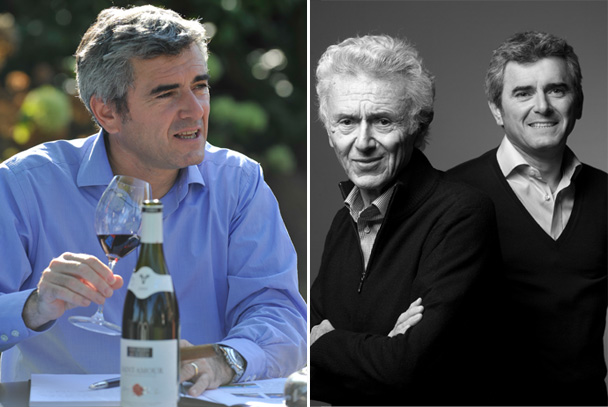Sandwiched between the more famous, glamorous regions of Burgundy and the Rhône, Beaujolais hasn’t always gotten respect. The wines, however—especially the crus, meaning those from the region’s officially designated 10 best areas—are some of the best values on the market.
And any fame accruing to the region and its grape, Gamay, is at least partly due to Georges Duboeuf, the négociant who reinvented Beaujolais’ image in the 1960s and 1970s through some breathtakingly savvy marketing. He created unforgettable labels covered with eye-catching flowers in a rainbow of colors—a sharp contrast to the dour Gothic lettering of typical French bottles of the period—and turned the autumn release of a just-bottled regional value wine, Beaujolais Nouveau, into an international event the third Thursday of each November.
Georges is now 77, and the reins of the family business are passing to his son, Franck, 50, who co-owns the company and will eventually have to navigate a far more competitive wine world that his father ever did. Regions in the Southern Hemisphere have already taken over as the source for much of the inexpensive wine market, for instance, and countries that never really made wine before (China! India!) are now getting in the game. “It’s not a question of following in his steps,” says the younger Duboeuf. “It’s an evolution. I always follow my father’s advice. We’ve been working together 25 years. But given the recent revolution in the wine economy, we have to innovate, too.”
Certainly he’s impressed by his father’s legacy—who wouldn’t be? “He came at the right moment 40 years ago,” says Duboeuf. “It was a kind of revolution.” Legacy, loyalty, and tradition are big parts of the son’s vocabulary. Ultimately, he’s blending and selling a product that isn’t going to dramatically change in its taste profile anytime soon (and many of us hope it doesn’t). Beaujolais was a staple of casual brasserie dining in 19th-century Paris, and it fulfills much the same role all over the world today.
The Duboeufs control 20 percent of Beaujolais’ output and produce 30 million bottles a year. The négociant’s role is key in a region that has 2,500 small growers—far more than its more prestigious neighbor Burgundy, for instance. “My father has enormous respect for the grower, and he was the first to acknowledge them on the label,” says Duboeuf. “He’s one himself.”
But, oddly, it’s a simpler region for consumers to understand because of the way the land is officially divvied up. “You need some knowledge to know and understand Burgundy, but Beaujolais is perfect for beginners,” says Duboeuf. “They have over 100 different appellations, and we have only 12—the 10 crus, Beaujolais, and Beaujolais Villages.”
Since almost all exported wine in the area is made from Gamay, Duboeuf understandably promotes the versatility of this grape. “Gamay can be an easy, pleasant red wine, aromatic and medium-bodied to drink, but it can also be taken more seriously. A Moulin-à-Vent can be a fantastic wine after 10 years in the cellar,” he says, referring to one of the top crus.
Over the decades, the Duboeufs have found that encouraging people to visit Beaujolais is a great way to help them understand the grape. They founded an “oenoparc” in Romanèche-Thorins called Le Hameau Du Vin in 1993, and Franck and his wife, Anne, manage it today. “We pioneered wine tourism,” says Duboeuf. “Wine destinations like that were not really known in France, but my father was really impressed with what Robert Mondavi and others had done. We’ve had 2 million people visit.”
Partially constructed from the town’s old railway station, Hameau has a wine museum with a 3-D movie theater, a café, a boutique, and even a wine-themed mini-golf course—and the specter of the increased global competition makes such ideas even more important these days. “We’re selling a culture, too, not just a wine,” says Duboeuf. “French gastronomy was once dominant and that helped us, but now Spain and all these other countries are producing such excitement.”



 Pinterest
Pinterest


